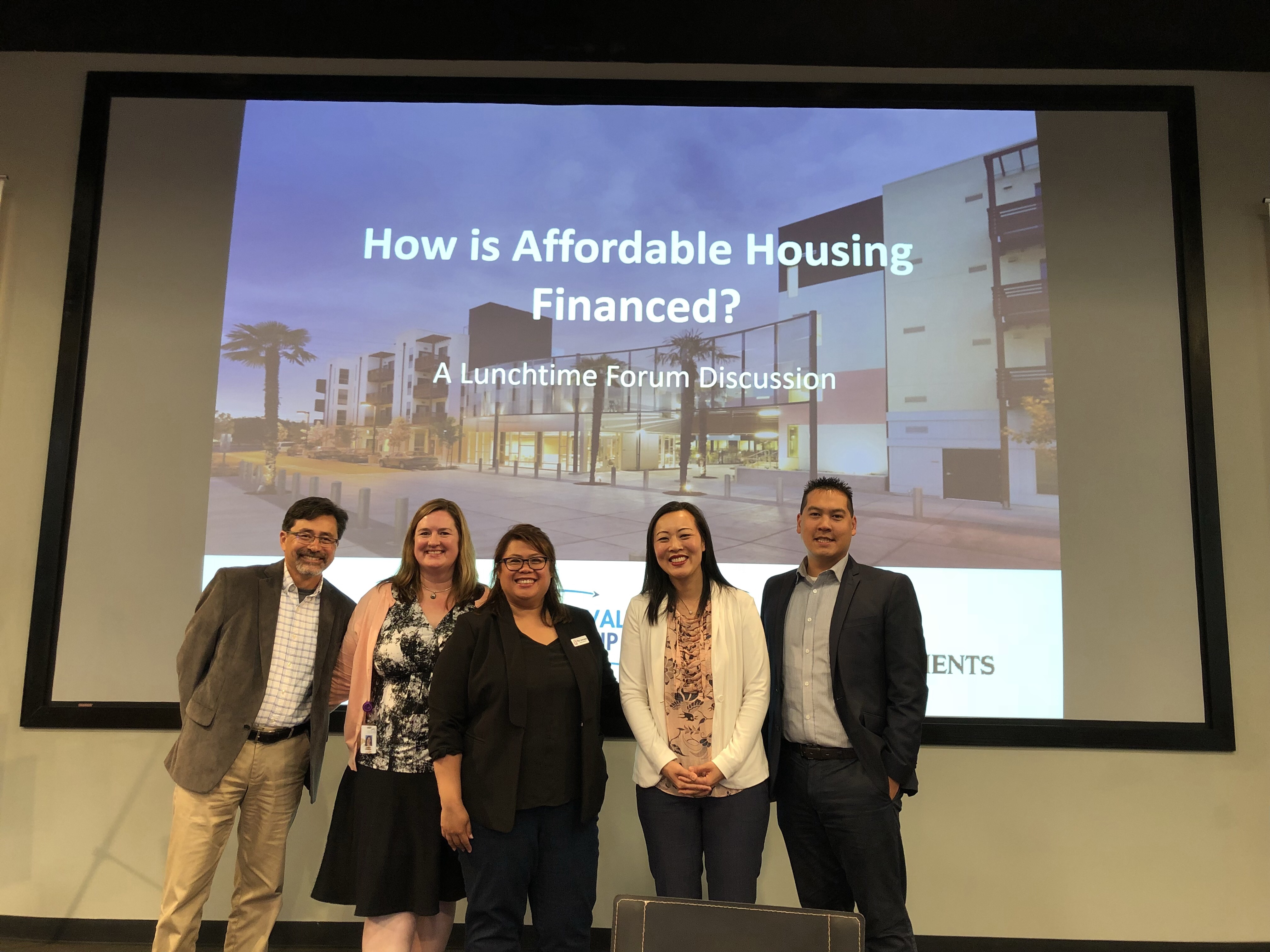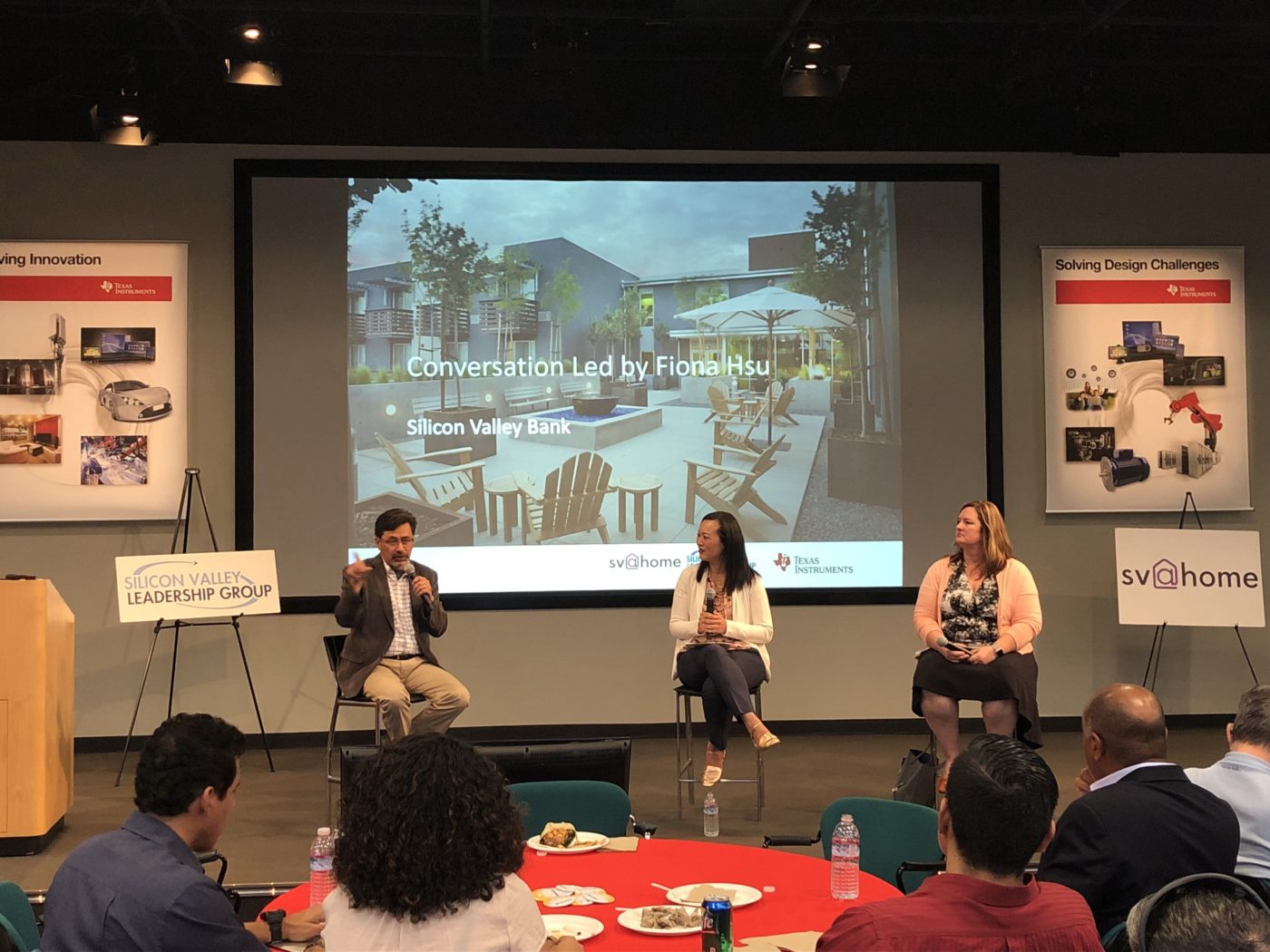For many, it’s hard to understand why it takes so long to get housing and especially affordable housing built. On average it can take five to seven years to develop, plan, and break ground on an affordable housing development.
SV@Home took steps to demystify the process during a September 12 lunchtime forum co-sponsored by the Silicon Valley Leadership Group at the Texas Instruments conference center in Santa Clara. In a conversation led by Silicon Valley Bank’s Fiona Hsu, Eden Housing Senior Vice President of Real Estate Development Andy Madeira and the City of San Jose’s Housing Policy Division Manager Kristen Clements delivered a primer on affordable housing finance.
“The residential development process is a race against time, since construction, land, and material costs typically rise over time”—Andy Madeira

Here are some of the key points that came out of the presentations:
- Affordable housing developers—It’s all about the land and the financing! A developer needs to identify land that is appropriate for the construction of affordable housing. And then the developer needs to assess feasibility by determining the financing package needed to fund the development. Affordable housing developers must compete with market-rate developers for limited land, and are not able to pay premium prices.
- Funding for affordable housing is complicated!—Developers must assemble a complex package of funding sources, including federal subsidies and tax credits, State and local funds, and conventional bank mortgages. Federal tax credits are the primary funding source for affordable housing, but they are also tricky. This is a complicated process, requiring specialized expertise.
- Maintaining a strong track record with local government lenders is key— Affordable housing developments target specific populations. It is important that projects brought forward serve these populations reliably throughout the term of the loan. Clements and her team work hard to ensure that developers receiving City funding have an established record of success both in terms of project development and project management.
- Projects should be reflective of local priorities — Affordable housing developers work with local housing staffers to iron out the wrinkles in a funding package. They may choose to target their development to specific populations such as veterans or seniors in order to access subsidies that have been prioritized by local government lenders. Clements recommends that developers keep these priorities in mind, as this allows them to move through the process more efficiently.
- Fastest development timelines— The fastest timeline for an affordable housing development Madeira has seen is three years, typically when an affordable housing developer partners with a market-rate developer who must include a certain percentage of affordable homes in their housing project under inclusionary zoning rules. This scenario allows affordable housing developers to concentrate on navigating the federal tax credit program, while the market-rate developer foots the bill for the rest of the construction.
Hsu dug deeper with the presenters, with a more in depth discussion on how affordable housing developers establish preferred and alternative financing paths in the event that they do not receive the funding they anticipated. Unlike market-rate developers who typically access traditional financing sources, affordable housing developers must layer funding from various public and private sources, all of which come with their own restrictions and requirements. And, developers must be nimble in addressing funding gaps created when funding sources don’t come through or when there are unanticipated cost increases.
The panel also noted a perceived shift in community sentiment, with more community members coming forward and speaking in favor of housing. Constituents are now expressing concerns that their families, friends, and co-workers can’t afford to live in the communities where they grew up, raised their families, and work. Madeira said this positive shift in messaging could result in shorter timelines for development approvals than previously experienced.
After the presentation, the speakers answered audience questions. In response to a question about whether the housing crisis could be solved by speeding up the construction of market-rate housing, Madeira pointed out that because construction costs are so high, market-rate developers are unable to address the housing needs of middle class and lower income families. As a result, only high-income earners benefit from the construction of market-rate housing. While SV@Home agrees that market-rate housing won’t solve the needs of our lower- and moderate-income residents and that the development of deed restricted affordable housing must be prioritized, we believe strongly in increasing the affordable housing supply for all.
Barring eliminating parking requirements, which Madeira agreed drive up costs, the most efficient way to reduce residential development costs is to build at high densities. This drives down the cost for each new home and helps developers recoup some of the high costs associated with land acquisition.
SV@Home’s Affordable Housing financing series continues on October 11, 2018. The next installment (A Walk Through of Market Rate Development) examines the cost of building market rate properties and looks at the incentives needed to ensure that market rate developers can meet their inclusionary requirements. Future panels will explore retail and parking requirements, how they impact the cost of development, and how the cost can be offset with innovative policies and products.

